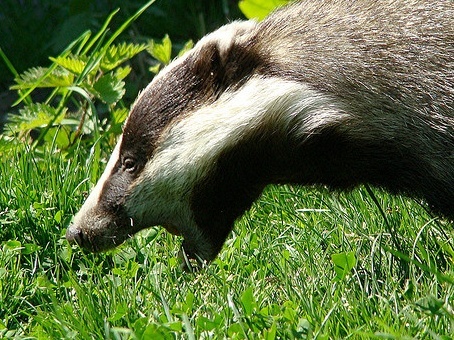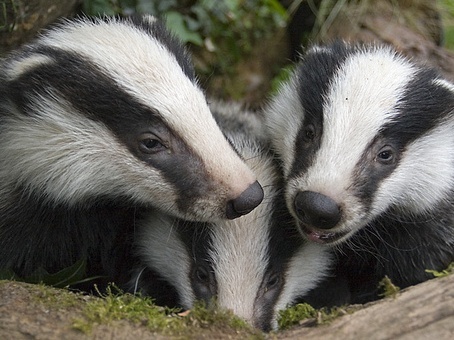RP Weather & Time

|
Time of Day: Light Flurries |
|
|
Season and Month: Winter - Jaunary (WC Territory) |
Year 3 (1972) |
|
Log in
Latest topics
Joining the Pack
Make sure to fill in a joining form on our STP Thread!
Accounts will not be activated until you do so!
Accounts will not be activated until you do so!
Top posting users this week
| No user |
Top posting users this month
| No user |
The Badger
Page 1 of 1 • Share
 The Badger
The Badger
──────────────────────────────────────────────────────────────────────────────────────
The Badger
──────────────────────────────────────────────────────────────────────────────────────
Adult

Cub

──────────────────────────────────────────────────────────────────────────────────────
General Information;
Type: Mammal
Diet: Omnivore
Size: Head and body, 23 to 30 in (60 to 70 cm)
Weight: 15.5 pounds to 25 pounds (7 to 11 kg)
Scientific Classification: Kingdom: Animalia, Phylum: Chordata, Class: Mammalia, Order: Carnivora, Family: Mustelidae.
Size relative to a 6-ft (2-m) man:

Badger Range

Badgers are short-legged omnivores in the weasel family, Mustelidae. There are nine species of badger, in three subfamilies (see links in species list below): Melinae (badgers of Europe and Asia), Mellivorinae (the Ratel or honey badger), and Taxideinae (the American badger). The Asiatic stink badgers of the genus Mydaus were formerly included in the Melinae and Mustelidae, but recent genetic evidence indicates that these are actually members of the skunk family, placing them in the taxonomic family Mephitidae.
──────────────────────────────────────────────────────────────────────────────────────
Physical Features;
Badgers have rather short, fat bodies, with short legs built for digging. Their ears are small, and they have elongated weasel-like heads, their tails vary in length depending on species, the stink badger has a very short tail, while the ferret badger's tail can be 18 to 20 inches (46 to 51 cm) long, depending on age. They have black faces with distinctive white markings, their bodies are gray with a light colored stripe from their head to their tail, they have dark legs with light colored stomachs. They grow to around 35 inches (89 cm) in length including tail. the European badger is one of the largest, the American badger, the hog badger and the honey badger are similar in size and weight, though generally a little smaller and lighter. The stink badgers are smaller still, and the ferret badgers are the smallest of all. They weigh around 20–24 pounds (9.1–11 kg) on average, with some Eurasian badgers weighing in at around 40 pounds (18 kg).
──────────────────────────────────────────────────────────────────────────────────────
Mental Features;
The behavior of badgers differs by family, but all shelter underground, living in burrows called setts, which may be very extensive. Some are solitary, moving from home to home, while others are known to form clans. Clan size is variable from 2 to 15. Badgers can be fierce animals and will protect themselves and their young at all costs. Badgers are capable of fighting off much larger animals such as wolves and bears. Badgers can run or gallop at up to 25–30 kilometres per hour (16–19 mph) for short periods of time.
──────────────────────────────────────────────────────────────────────────────────────
Diet;
The diet of the Eurasian badger consists largely of earthworms, insects, and grubs. They also eat small mammals, amphibians, reptiles and birds as well as roots and fruit. Indeed, in southern Spain, badgers mostly feed on rabbits. The honey badger of Africa consumes honey, porcupines and even venomous snakes (such as the puff adder). They will climb trees to gain access to honey from bees' nests. American badgers are fossorial carnivores. Unlike many carnivores that stalk their prey in open country, badgers catch most of their food by digging. They can tunnel after ground-dwelling rodents with amazing speed. Badgers have been known to become intoxicated with alcohol after eating rotting fruit.
──────────────────────────────────────────────────────────────────────────────────────
Wolf vs. Badger;
Badgers tend to not pose as much of a threat to wolves, infact, it's more like the opposite. Wolves a natural predators to badgers, as they have been known to kill the cubs of badgers. Also, wolves have also been known to somewhat provide food for badgers as well as other animals (e.g. the food they leave behind after a hunt). However, if these two creatures were to battle each other, one of the badgers advantages would be the large claws it has, which are usually used for digging out burrows underground. On the other hand, wolves have a pack, claws and large teeth to accompany them within a fight (if the fight was with a solo wolf, then the wolf would only have it's claws and teeth).
──────────────────────────────────────────────────────────────────────────────────────
Credits (c);
Images:
http://www.flickr.com/photos/hinch69/5768145808/
http://www.flickr.com/photos/finlap/2476040248/
Information:
http://en.wikipedia.org/wiki/Badger
http://www.oregonwild.org/fish_wildlife/bringing_wolves_back/wolves-misunderstood
──────────────────────────────────────────────────────────────────────────────────────
The Badger
──────────────────────────────────────────────────────────────────────────────────────
Adult

Cub

──────────────────────────────────────────────────────────────────────────────────────
General Information;
Type: Mammal
Diet: Omnivore
Size: Head and body, 23 to 30 in (60 to 70 cm)
Weight: 15.5 pounds to 25 pounds (7 to 11 kg)
Scientific Classification: Kingdom: Animalia, Phylum: Chordata, Class: Mammalia, Order: Carnivora, Family: Mustelidae.
Size relative to a 6-ft (2-m) man:

Badger Range

Badgers are short-legged omnivores in the weasel family, Mustelidae. There are nine species of badger, in three subfamilies (see links in species list below): Melinae (badgers of Europe and Asia), Mellivorinae (the Ratel or honey badger), and Taxideinae (the American badger). The Asiatic stink badgers of the genus Mydaus were formerly included in the Melinae and Mustelidae, but recent genetic evidence indicates that these are actually members of the skunk family, placing them in the taxonomic family Mephitidae.
──────────────────────────────────────────────────────────────────────────────────────
Physical Features;
Badgers have rather short, fat bodies, with short legs built for digging. Their ears are small, and they have elongated weasel-like heads, their tails vary in length depending on species, the stink badger has a very short tail, while the ferret badger's tail can be 18 to 20 inches (46 to 51 cm) long, depending on age. They have black faces with distinctive white markings, their bodies are gray with a light colored stripe from their head to their tail, they have dark legs with light colored stomachs. They grow to around 35 inches (89 cm) in length including tail. the European badger is one of the largest, the American badger, the hog badger and the honey badger are similar in size and weight, though generally a little smaller and lighter. The stink badgers are smaller still, and the ferret badgers are the smallest of all. They weigh around 20–24 pounds (9.1–11 kg) on average, with some Eurasian badgers weighing in at around 40 pounds (18 kg).
──────────────────────────────────────────────────────────────────────────────────────
Mental Features;
The behavior of badgers differs by family, but all shelter underground, living in burrows called setts, which may be very extensive. Some are solitary, moving from home to home, while others are known to form clans. Clan size is variable from 2 to 15. Badgers can be fierce animals and will protect themselves and their young at all costs. Badgers are capable of fighting off much larger animals such as wolves and bears. Badgers can run or gallop at up to 25–30 kilometres per hour (16–19 mph) for short periods of time.
──────────────────────────────────────────────────────────────────────────────────────
Diet;
The diet of the Eurasian badger consists largely of earthworms, insects, and grubs. They also eat small mammals, amphibians, reptiles and birds as well as roots and fruit. Indeed, in southern Spain, badgers mostly feed on rabbits. The honey badger of Africa consumes honey, porcupines and even venomous snakes (such as the puff adder). They will climb trees to gain access to honey from bees' nests. American badgers are fossorial carnivores. Unlike many carnivores that stalk their prey in open country, badgers catch most of their food by digging. They can tunnel after ground-dwelling rodents with amazing speed. Badgers have been known to become intoxicated with alcohol after eating rotting fruit.
──────────────────────────────────────────────────────────────────────────────────────
Wolf vs. Badger;
Badgers tend to not pose as much of a threat to wolves, infact, it's more like the opposite. Wolves a natural predators to badgers, as they have been known to kill the cubs of badgers. Also, wolves have also been known to somewhat provide food for badgers as well as other animals (e.g. the food they leave behind after a hunt). However, if these two creatures were to battle each other, one of the badgers advantages would be the large claws it has, which are usually used for digging out burrows underground. On the other hand, wolves have a pack, claws and large teeth to accompany them within a fight (if the fight was with a solo wolf, then the wolf would only have it's claws and teeth).
──────────────────────────────────────────────────────────────────────────────────────
Credits (c);
Images:
http://www.flickr.com/photos/hinch69/5768145808/
http://www.flickr.com/photos/finlap/2476040248/
Information:
http://en.wikipedia.org/wiki/Badger
http://www.oregonwild.org/fish_wildlife/bringing_wolves_back/wolves-misunderstood
──────────────────────────────────────────────────────────────────────────────────────

Guest- Guest
Page 1 of 1
Permissions in this forum:
You cannot reply to topics in this forum






 by Guest Mon Feb 13, 2012 9:14 pm
by Guest Mon Feb 13, 2012 9:14 pm
» The Clinic
» Gypsy Stables
» Gypsy Kingdom Castle
» Gypsy Shop - Meluna's Merchandise
» Spirits and Ranks of STP
» Gypsy Kingdom Sign Up